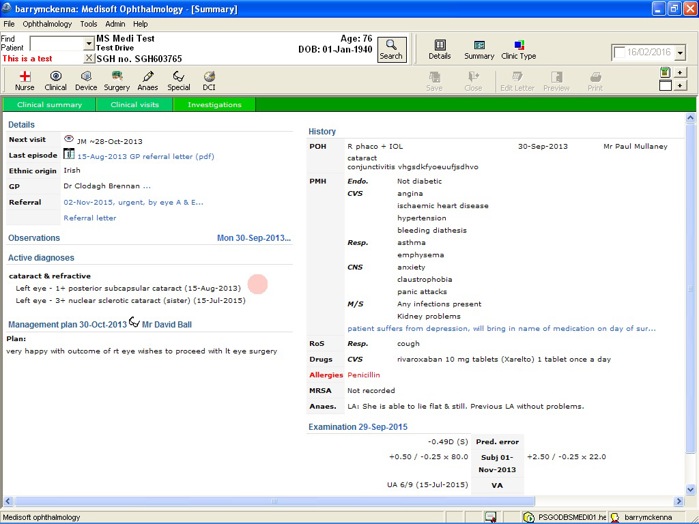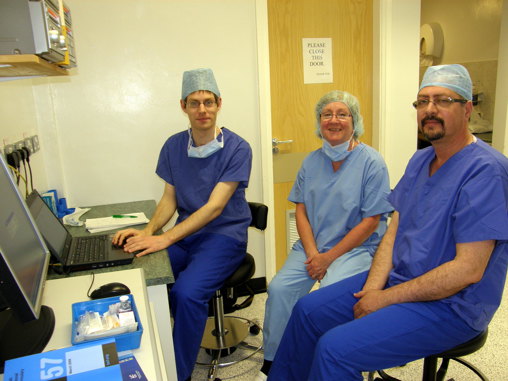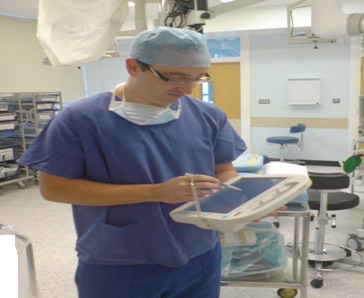Ophthalmology Electronic Patient Record
Introduction:
The Cataract surgical service in Sligo University Hospital (SUH) provides services for patients from Sligo, Donegal, Leitrim, West Cavan, Mayo and Longford areas. Patients are often seen in the community setting, and have their surgery in Sligo if needed and come back to the community for their post surgery review. Accurate flow of information is paramount to the overall smooth running of this service.
With this in mind the Ophthalmology service, led by two consultant ophthalmologists, established a team to implement an Electronic Patient Record (EPR) for the service. This multidiscipline team included specialty nurses, admin staff, ICT, doctors and community ophthalmologists. The EPR established would have to be usable across both acute and community settings throughout and would need to be available in the west/north west region.
Our goal was to implement a comprehensive, integrated electronic ophthalmology clinical record system which would improve access to patient information. This clinical record would also efficiently record patient outcomes, effectively communicate with practitioners in the community, and provide a tool for clinical audit.
Our objectives to realise the above goal are as follows:
- Successfully implement an integrated electronic patient record system for patients attending for cataract surgery.
- Allow easy access for acute and community practitioners (Medical Ophthalmologists and Optometry practices) to real time information through different stages of the cataract patient pathway from first clinic visit, pre-surgical assessment, theatre, and post-operative visit in the acute or community clinic.
- Ensure high quality clinical information is recorded in a consistent manner, through a pre-defined electronic datasets.
- Assist in improved clinical decision making, clinical audit, research and benchmarking.
- Reduce paper resulting in smaller charts and reduce costs for the Speciality.
- Improve security and safety of patient records.
The Challenge
The practice of recording clinical care episodes on paper from multiple geographic locations resulted in duplication of information and the constant movement of paper chart copies from the various locations resulting in voluminous paper charts. This led to inefficiencies and risk in terms of timely access to patient information, paper notes going missing, security of information and illegible notes. Carrying out clinical audits was labour intensive and very often took many weeks to complete by trying to access relevant information from paper charts distributed across the region. The service firmly believe the only way to address these challenges is to invest in ICT and recognise that many of the challenges identified could be solved by introducing an integrated electronic patient record across the region.
The Solution

It was agreed to implement an EPR for the Cataract Surgical Service called Medisoft, a software package that would include the following features:-
- Provide an Electronic Patient Record [EPR] for the Cataract Surgical Service.
- Maintain an integrated record digitising each stage of Cataract patient pathway regardless of where the patient had their episode of care.
- Hosted on a hospital server – peripheral clinics linked – no carrying of patient records with merging of multiple patient medical record numbers from different sites and interfacing with the hospital IT Systems [IPMS] to retrieve patient demographic data.
- Referrals scanned in prior to clinic, and Notes for GP, Optician and Pharmacy printed immediately
- All letters completed as a batch print at end of clinic.
- Linked to theatre via wireless tablets where operative details inputted at the end of each case.
- Direct Integration with Ophthalmology imaging equipment.
- Generate Audits more easily and all information can easily be reviewed from any location, allowing outcomes reporting, research and service demand forecasting.
- Linked to Community Ophthalmologists with who many patients are under shared care.
- Linked to over seventy one Community Optometrists for follow up of post cataract patients locally. As the cataract pathway was generating so many postoperative reviews, the team wanted to free up clinical time for new patient referrals. Post-operative follow up of uncomplicated cases, without ocular comorbidity is transferred to the community Optometrists. These practitioners were already seeing these patients for refraction and spectacle provision. This enables the patient to remain in their local community and removes the duplication in the system by removing the hospital doctor review. The EPR enabled optometrists to input their clinical data thus allowing closure of the loop, feedback and audit and still maintaining an integrated patient record.
Benefits for all
- 1422 patients are referred annually out and followed up in their communities this has allowed >1400 other patients to be seen in hospital reducing OPD waiting lists
- A fully integrated electronic system shared between the acute and community ophthalmology service thus maintaining an integrated, “single source of truth” patient record.
- Greatly increased throughput of patients in theatre by having information instantly available.
- Improved quality and safety within the service -streamlined and more efficient pathways from a patient perspective, this revised pathway is much more patient friendly in that it removes the requirement for patients (often elderly) to travel long distances to their hospital for follow up review post-surgery.
- Reduce risk for the patient as there are no lost notes and imaging equipment sends data directly to the EPR thus reducing any transcription errors.
- Enhanced communication links between the Community Optometrists and the Ophthalmology team provide a more integrated service. The Optometrist has the facility to list the patient for their second cataract directly via the EPR if the doctor listing the patient for their first operation has directed that this is appropriate. (The listing surgeon defines at the initial visit whether the patient can be listed for the second eye surgery if all has settled at the post op review and if the patient wished to proceed).
- Significant reduction in paper and the movement of paper between the acute and community service.
- An auditable, secure EPR.
- Easy access to clinical audit Information to support service planning needs.
The level of engagement/ training and commitment from both the Acute Hospital and Community staff has been a key contributor to the success to date and is paving the way forward for further integration in the service. A project is already underway in this respect in moving forward to provide one integrated Ophthalmology service between hospital and community partners.

One of the key advantages to this innovative development is the transferability on information to other units or indeed other hospitals throughout the region and beyond. Whilst the success to date has been enabled by the nature of the service (in that it is a relatively distinct entity) it demonstrates how successful this project could be on a much larger scale and it has been adopted by the National Clinical Ophthalmology Programme as their model for cataract care.
Next Steps
Over time the Ophthalmology service plans to extend Medisoft into other sub specialty areas. Medisoft was concurrently introduced in the medical retina service, as well as being used in the cataract service. As with the cataract pathway Medisoft is used in clinics and theatre, and facilitates the implementation of nurse or optometrist led virtual clinics and access to patient’s records in the community ophthalmology clinics when patients are under joint care or being referred back to either acute or community services. Since July 2015 the Medisoft emergency eye clinic module is used in SUH; this facilitates rapid generation of replies to referring GPs and optometrists, and easy access to casualty notes. Finally, the team recently extended Medisoft to Paediatrics and Glaucoma subspecialties allowing Medisoft to become a fully integrated EPR across all Ophthalmology sub specialties.
Furthermore, it is envisaged that there will be increased use of Medisoft for Community Ophthalmology clinics across Sligo, Donegal, Leitrim, West Cavan, Mayo and Longford to facilitate flow of information between sites without the need to move patient charts between clinic locations. As Ophthalmology is dependent on imaging, the service plans to integrate an image management solution called Forum Zeiss with Medisoft during 2016, which will integrate both imaging and the patient’s clinical record through one single logon via Medisoft.
This will further enhance the concept of a single, integrated ophthalmology patient record across different hospital and community sites serving what has become an integrated service across the acute and community care setting with the West/North West region.
Written by: Barry McKenna.
Proof Read and updates by:
Paul Mullaney: Consultant Ophthalmologist, SUH.
Shauna Quinn: Consultant Ophthalmologist, SUH.
Fidelma Kerins: Clinical Nurse Manager, Ophthalmology, SUH.
Jo Short: Senior Project Manager, SUH.
- Ambulance Arrivals Project A Case Study
- SNOMED National Release Centre (NRC)
- SVUH Award winning Patient Flow Whiteboard
- Scan for Surgery
- Hospital-based care
- Digital Natives Sign App
- Digitisation of risk assesment tools for Adult mental health services in north Dublin
- Patient Engagement Operating Systems - Hep C
- Digital Transition for HSCPs at St. James's Hospital
- Primary Care Centre Castlebar Case Study
- Mario - Managing active and healthy ageing using caring service robots
- Claimsure - Health Insurance Claims Management System
- Cyber Attack Response
- Data systems in SVUH Emergency Department
- Electronic Discharge Prescription Pilot
- Epilepsy EPR
- eReferral
- eReferral Radiology Pilot
- eRostering
- Electronic Blood Tracking
- GP Practice Management Systems
- Healthmail
- Heart Failure Virtual Clinic
- Infrastructure - MPUP to ECAM
- IT Security - Small changes, big difference
- Kidney Disease Clinical Patient Management System
- Local Asset Mapping Project at St James' Hospital
- LUCY
- Mi Kidney App
- Model Community
- NCHD - Employment Record Portal
- Nursing & Midwifery Quality Care Metrics
- Ophthalmology Electronic Patient Record
- PharmaBuddy
- Radiology & Electronic Patient Record
- National Smart-Pump Drug Library of Paediatric and Neonatal Standardised Concentration Infusions
- Quality & Patient Safety
- Robotic Assisted Surgery Programme
- Shared Learning on EHR
- St. James' Hospital - National Haemophilia System
- Tallaght Hospital Pharmacy
- Tallaght Hospital Patient Engagement App
- Track & Trace
- Using IT to Improve Ireland's Public Sector Healthcare
- National Audiology Clinical Management System (NA-CMS)
- St Vincent's University Hospital Award Winning Whiteboard Patient Flow System
- Snomed Case Study
- Telehealth Project Donegal
- St Vincent's Whiteboard Patient Journey System a Case Study
- Ambulance Arrivals Project

